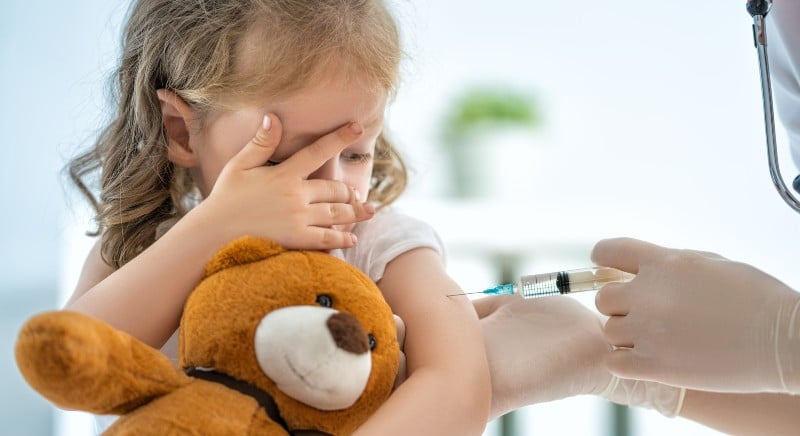Respiratory virus season is upon us. In light of that, many are headed to get COVID, flu, and maybe even RSV vaccines. But those under age five are less likely to get vaccinated for COVID-19. Why is that? And what if pediatric COVID-19 vaccination rates could be increased solely by making the choice easier for parents? Let’s look at how this might work.
In the US, children under five years of age have the lowest COVID-19 vaccination status of any age group, with just 13.2% of this age group having completed the primary series. This has been widely couched as a popularity problem in that parents are unwilling to, or uninterested in, vaccinating their children.
While we may have a popularity problem with pediatric COVID-19 vaccines, as studies have noted and as misinformation has amplified, stopping there offers an incomplete analysis. For example, authors of a recent study published in the Annals of Medicine noted,
“Examining disparities in child/adolescent vaccination coverage, such as by parental age and other sociodemographic characteristics, parental intent for vaccination and possible reasons for non-vaccination, is important for developing targeted strategies to increase parents’ confidence and reduce barriers to COVID-19 vaccines.”
Yet, targeted strategies alone will not increase vaccination rates. That’s because low vaccination rates are not solely an issue of parental confidence in the vaccine. The last part of the authors’ sentence quoted above, however, is the most critical to address: “reduce barriers to COVID-19 vaccines.” This is acknowledging the fact that accessing COVID-19 vaccines for children is onerous.
The complexity of the vaccination process is overwhelming
First, depending on their age, children get a different dose, number of shots for a primary series (three for Pfizer-BioNTech, two for Moderna, N/A for Novavax), and the space between the shots differs (three weeks between shots one and two for Pfizer, then two months before shot three, versus four weeks between Moderna shots, N/A for Novavax).
One particularly difficult barrier for children under five years old is identifying where one can get a vaccine for their child. See the table below for more detail.
| Age | 6 months – 4 years | 5 years – 11 years | 12 years+ | ||
| Vaccine dosing and (shots) by age | mRNA | Moderna | 25 ug (2) | 50 ug (2) | |
| Pfizer-BioNTech | 3 ug (3) | 10 ug (3) | 30 ug (2) | ||
| Protein- based | Novavax | N/A | N/A | 5 ug rS protein and 50 ug Matrix-M adjuvant (1) | |
| Vaccination location by age | Pediatrician | Yes | |||
| Health department | Yes | ||||
| Retail pharmacies* | CVS | No | Yes | ||
| CVS-Minute Clinic | Only 18 months+ | Yes | |||
| Walgreen’s | Only 3 yrs+ | Yes | |||
| Walmart | Only 3 yrs+ | Yes | |||
As you can see, the options for vaccine location increase and simplify at age 5 and above, which likely explains at least some of the increase in vaccination rates in these age groups.
Now, if location were the only dimension that parents had to consider, it might be feasible to increase rates. A simple look at this table indicates that it’s easiest to go to the pediatrician or health department to get your young child vaccinated.
But, that’s not all a parent must consider. In addition to finding where you can vaccinate your young child, you must then determine if the location that is able to vaccinate them also carries the vaccine that you need.
The CDC’s guidelines state that children under age 12 who have completed the primary series must stick with the same brand for this year’s shot. Therefore, if a parent found a way to vaccinate their two-year old with Moderna in 2022, they now have to find a location that 1) will vaccinate a three-year old, and 2) carries the vaccine they need, and 3) is within a reasonable travel distance from their home/office, and 4) has an available appointment at a time that aligns with their ability to get to it. That is a lot of interfaces for a parent to connect.
And that’s precisely why framing this as a popularity problem doesn’t tell the whole story. To improve vaccination rates, we must also acknowledge the modularity problem at hand. What do I mean by that?
Interdependence vs. Modularity
Part of this issue is explained by the Theory of Interdependence and Modularity. In brief, once a product or service reliably delivers for customers, individual parts and their interactions become standardized. This creates a state of modularity where many suppliers can compete to deliver one or more modules of a service more cheaply and quickly. It’s worth noting that the implementation of either modularity or interdependence does not determine whether a product is adopted, but predicts how quickly adoption will occur.
In the case of COVID vaccines, the market is operating as a series of modules: vaccines are produced by drug manufacturers; vaccines are distributed to pharmacies, health departments, and doctor’s offices; parents decide whether to vaccinate their child(ren) and with which vaccine; then they select where to do so. However, this modularized approach isn’t working well given the lack of standardization between the component parts of the system.
For example, Moderna requires two shots for a primary series, whereas Pfizer requires three. Moderna requires a four-week wait between shots, whereas Pfizer requires a three-week wait for shot two, and then two months before shot three. Some pharmacies will vaccinate a three-year-old, but some won’t until the child is five. Some CVS locations carry Moderna and Pfizer, others only Pfizer, others only Moderna. Pediatricians are inconsistent in which vaccines they provide, and if they provide them at all.
The modular approach was chosen during the pandemic for speed and quick adoption. This was wise as modular architectures are faster, more flexible, and more responsive than interdependent ones. However, interdependent architectures are optimized for functionality and reliability. When it comes to pediatric COVID vaccines, parents need functionality and reliability, but an interdependent architecture where one organization owns everything from manufacturing to administering vaccines isn’t possible.
Therefore, to increase vaccination rates, we need standardized interfaces between the different components of the system. That must include the following, at a minimum:
- Standardization of the ages retail pharmacies will vaccinate,
- Standardization on which vaccines retail pharmacies will carry,
- Standardization around whether pediatricians and health departments will offer the vaccines, and which ones they will offer,
- Consistency year over year. We cannot expect parents to repeat the onerous process of finding the vaccine their child needs on an annual basis.
If we can’t create seamless interfaces, we will continue to have what appears to be a popularity problem with pediatric COVID vaccines. But at its root, what we really have is a modularity problem.



